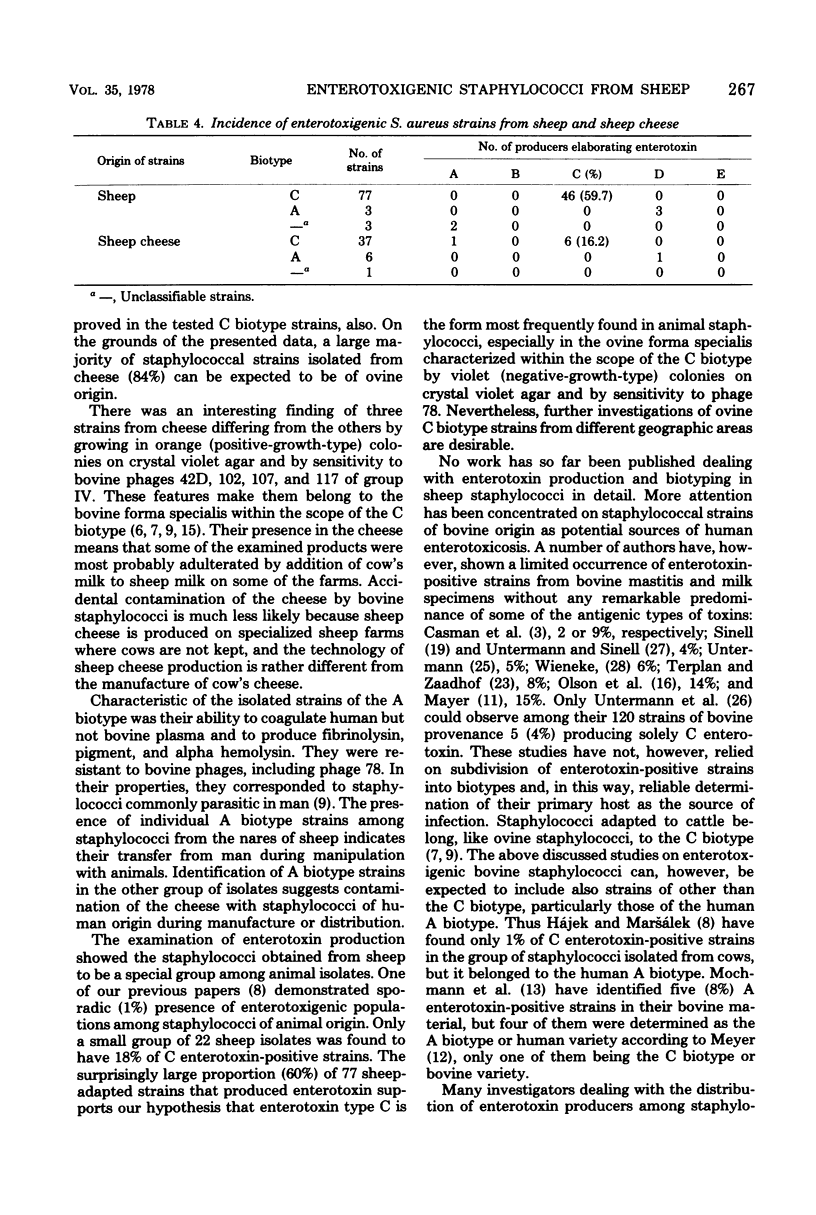Abstract
The total of 127 Staphylococcus aureus strains obtained from sheep and sheep cheese were examined for their biochemical activities, biotypes, phage patterns, and ability to produce enterotoxins. Of the 83 staphylococcal strains isolated from animals 77 (93%) were classified as the C biotype. Of this group of sheep-adapted strains, 61 (79%) were sensitive to phage 78, and 46 (60%) produced enterotoxin C exclusively. The three isolated belonging to the A biotype produced enterotoxin D, and two of the three unclassifiable strains produced enterotoxin A. Of the 44 staphylococcal strains isolated from sheep cheese, there were 37 (84%) identified as the C biotype. From this series, 31 (84%) strains were lysed with phage 78, 6 (16%) strains produced enterotoxin C, and 1 strain produced enterotoxin A. One of the six strains determined as the A biotype produced enterotoxin D. C biotype strains, especially of ovine origin, are an exception among animal staphylococci, because a large number of them are enterotoixgenic. The C antigenic type is the most usual of the known enterotoxins in staphylococci of animal provenance.
Full text
PDF




Selected References
These references are in PubMed. This may not be the complete list of references from this article.
- Casman E. P., Bennett R. W., Dorsey A. E., Issa J. A. Identification of a fourth staphylococcal enterotoxin, enterotoxin D. J Bacteriol. 1967 Dec;94(6):1875–1882. doi: 10.1128/jb.94.6.1875-1882.1967. [DOI] [PMC free article] [PubMed] [Google Scholar]
- Gilbert R. J., Wieneke A. A., Lanser J., Simkovicová M. Serological detection of enterotoxin in foods implicated in staphylococcal food poisoning. J Hyg (Lond) 1972 Dec;70(4):755–762. doi: 10.1017/s0022172400022592. [DOI] [PMC free article] [PubMed] [Google Scholar]
- Hájek V., Marsálek E. A study of staphylococci of bovine origin Staphylococcus aureus var. bovis. Zentralbl Bakteriol Orig. 1969 Jan;209(2):154–160. [PubMed] [Google Scholar]
- Hájek V., Marsálek E. Differenzierueng pathogener Staphylokokken und Vorschlag für ihre taxonomische Klassifikation. Zentralbl Bakteriol Orig A. 1971 Jun;217(2):176–182. [PubMed] [Google Scholar]
- Hájek V., Marsálek E. The occurrence of enterotoxigenic staphylococcus aureus strains in hosts of different animal species. Zentralbl Bakteriol Orig A. 1973 Jan;223(1):63–68. [PubMed] [Google Scholar]
- Meyer W. Differenzierungsschema für Standortvarianten von Staphylococcus aureus. Zentralbl Bakteriol Orig. 1966 Dec;201(4):465–481. [PubMed] [Google Scholar]
- Mochmann H., Richter U., Karsch W., Witte W., Meyer W. Untersuchungen über die Enterotoxin-Bildung von Staphylococcus aureus-Stämmen unterschiedlicher Herkunft. Zentralbl Bakteriol Orig A. 1976 May;234(4):434–449. [PubMed] [Google Scholar]
- Oeding P., Hájek V., Marsálek E. A comparison of antigenic structure and phage pattern with biochemical properties of Staphylococcus aureus strains isolated from sheep. Acta Pathol Microbiol Scand B. 1976 Feb;84(1):61–65. doi: 10.1111/j.1699-0463.1976.tb01902.x. [DOI] [PubMed] [Google Scholar]
- Oeding P., Marandon J. L., Hájek V., Marsálek E. A comparison of phage pattern and antigenic structure with biochemical properties of Staphylococcus aureus strains isolated from cattle. Acta Pathol Microbiol Scand B Microbiol Immunol. 1971;79(3):357–364. doi: 10.1111/j.1699-0463.1971.tb00073.x. [DOI] [PubMed] [Google Scholar]
- Olson J. C., Jr, Casman E. P., Baer E. F., Stone J. E. Enterotoxigenicity of Staphylococcus aureus cultures isolated from acute cases of bovine mastitis. Appl Microbiol. 1970 Oct;20(4):605–607. doi: 10.1128/am.20.4.605-607.1970. [DOI] [PMC free article] [PubMed] [Google Scholar]
- Osváth-Marton A., Domján J. Enterotoxin production by Staphylococcus aureus strains in Hungary. J Hyg Epidemiol Microbiol Immunol. 1974;18(3):289–292. [PubMed] [Google Scholar]
- Payne D. N., Wood J. M. The incidence of enterotoxin production in strains of Staphylococcus aureus isolated from foods. J Appl Bacteriol. 1974 Sep;37(3):319–325. doi: 10.1111/j.1365-2672.1974.tb00446.x. [DOI] [PubMed] [Google Scholar]
- Simkovicová M., Gilbert R. J. Serological detection of enterotoxin from food-poisoning strains of Staphylococcus aureus. J Med Microbiol. 1971 Feb;4(1):19–30. doi: 10.1099/00222615-4-1-19. [DOI] [PubMed] [Google Scholar]
- Terplan G., Zaadhof K. J. Zur diagnostischen und lebensmittelhygienischen Bedeutung von Staphylococcus aureus in Kuhmilch. Dtsch Tierarztl Wochenschr. 1969 May 11;76(9):217–221. [PubMed] [Google Scholar]
- Toshach S., Thorsteinson S. Detectionn of staphylococcal enterotoxin by the gel diffusion test. Can J Public Health. 1972 Jan-Feb;63(1):58–66. [PubMed] [Google Scholar]
- Untermann F., Sinell H. J. Beitrag zum Vorkommen enterotoxinbildender Staphylokokken. Zentralbl Bakteriol Orig. 1970;215(2):166–172. [PubMed] [Google Scholar]
- Wieneke A. A. Enterotoxin production by strains of Staphylococcus aureus isolated from foods and human beings. J Hyg (Lond) 1974 Oct;73(2):255–262. doi: 10.1017/s0022172400024104. [DOI] [PMC free article] [PubMed] [Google Scholar]


